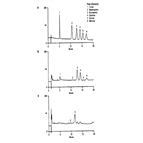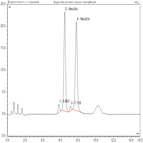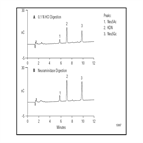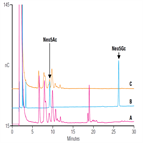Find methods for your needs
Refine by Feature
Displaying 1-5 of 5 results for Tag: sialic acid
TN30: Monosaccharide and Oligosaccharide Analysis of Glycoproteins Electrotransferred onto Polyvinylidene Fluoride (PVDF) Membranes
Instrument Type: ICThis older TN shows how HPAE-PAD carbohydrate analysis can be performed from a PVDF blot. The TN shows monosaccharide, oligosaccharide, and sialic acid analyses. This record reports the monosaccharide analysis method. For updated monosaccharide, sialic acid, and oligosaccharide analysis methods please see records for TN40, AU180, AU181, and AN1050.
Direct measurement of sialic acids from glycoprotein hydrolysis by HPLC-CAD
Instrument Type: HPLCA isocratic method was developed for determine sialic acids content in glycoprotein using Thermo Scientific U3000 HPLC system with charged aerosol detector. Sialic acids were released from human and bovine transferrin with enzyme digestion and seperated on a Dionex Trinity P2 column without derivatization. N-acetylneuraminic acid and N-glycolyneuraminic acid can be determined in less than 12 min with this method. Sample solvent: 40% 100mM ammonium acteate at pH5, 60% acetonitrile
TN41: Analysis of Sialic Acids Using High-Performance Anion-Exchange Chromatography
Instrument Type: ICLinearity, detection limits, reproducibility, and accuracy of HPAE-PAD analysis of Neu5Ac and Neu5Gc are evaluated in this Technical Note. A variety of ways to separate Neu5Ac, Neu5Gc, and KDN (3-deoxy-D-glycero-D-galacto-2-nonulosonic acid), an internal standard, using the CarboPac PA10 column as well as methods to release sialic acids from glycoproteins are included in this Note. Readers should also see AU141, AU180, and AU181.
AU141: Improved Long-Term Stability of N-Acetylneuraminic Acid and N-Glycolylneuraminic Acid Peak Area Responses Using Waveform A, a Quadruple Potential Waveform
Instrument Type: ICIn TN41, “Analysis of Sialic Acids Using High-Performance Anion-Exchange Chromatography”, we showed that the sialic acid content of a glycoprotein could be accurately and reproducibly determined by HPAE-PAD. That Note showed the separation of Neu5Ac, Neu5Gc, and the internal standard 3-deoxy-D-glycero-D-galacto-2-nonulosonic acid. In this Application Update we show that Waveform A offers 48h peak area reproducibility (peak area RSDs <5%) for sialic acids analyzed by HPAE-PAD similar to that reported in TN41, and improved reproducibility of peak area response with long-term (> 48 h) use.
AN215: Separation of Asparagine-Linked (N-Linked) Oligosaccharides from Human Polyclonal IgG
Instrument Type: ICThis application note shows how the PA200 improves N-linked oligosaccharide separations. The PA200 is used to profile N-linked oligosaccharides released from human polyclonal IgG by the enzyme PNGase F or endoglycosidase H (Endo H). This note also shows how subsequent exoglycosidase digestions can be used to assist in understanding and identifying oligosaccharide structure.





